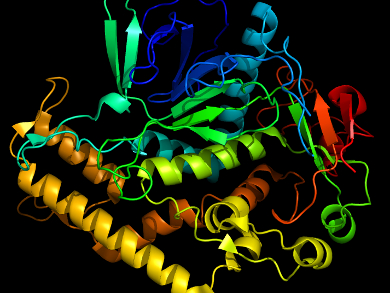Neurotoxins can be Difficult to Detect
There are countless proteins that analytical scientists would like to be able to test for in a wide range of samples. For instance, it would be useful to be able to quickly detect the presence of botulinum toxin or the lethal carbohydrate-binding protein ricin (a lectin), in a variety of situations: medical, environmental, or in the event of a biological attack. Protein toxins are notoriously difficult to test for, however, as they require rather complex and laborious techniques that do not lend themselves to an urgent response.
Andrew J. Bonham, Metropolitan State University, Denver, CO, USA, and colleagues have developed electrochemical aptamer biosensors that have proved themselves useful in tests for both the botulinum and ricin neurotoxins. The team suggests that the approach is robust enough and sufficiently specific for detecting nanomolar concentrations of the target protein. Moreover, the test works in dilute blood serum. The team reports in the journal Chemical Communications that their “biosensors may aid future efforts for the rapid diagnosis of toxins.” The same approach might well be extended to other toxic proteins.
Botulinum and Ricin
The researchers point out that soil bacterium Clostridium botulinum, well known for its toxin which causes the potentially fatal disease botulism, can be transferred to humans through poor food hygiene or contaminated needles in drug use and abuse. While it is known for its cosmetic and medical applications as a muscle relaxant, its potential as a rather nasty agent of biological warfare is a serious concern. Current tests for botulinum either rely on mouse inoculation or ELISA (enzyme-linked immunosorbent assay) tests, all of which have a turnaround time of two to five days. Unfortunately, botulism, once contracted, acts rapidly and is often fatal in a much shorter timeframe.
Similarly, the protein ricin, produced by the castor oil plant Ricinus communis, is lethal to humans at a dose of less than one milligram per kilogram of body mass. It too is an infamous biological warfare agent and its lethal effects take a mere six to twelve hours to become manifest. Once again, a rapid onsite test for this protein would be of great utility for medical responders, emergency services, and the military.
Aptamers Bind to a Specific Target
In the search for rapid tests for specific biological analytes of medical interest, one recent approach has been the development of biosensors that exploit a highly specific interaction between the target and the sensor: electrochemical DNA-based sensors (E-DNA sensors). Such sensors have an oligonucleotide (e.g. DNA) scaffold presenting an “aptamer” sequence that binds the protein and an electrochemically active group, such as methylene blue, that easily gives up or takes up electrons. This aptamer is chemically attached to a gold electrode, which is then used to electrochemically determine whether or not it has bound its target.
The single-step convenience of this method allows for analysis in minutes rather than days. To date, other sensors in this class have been reported for the detection of oligonucleotides, small molecule drugs, antibodies, and DNA-binding proteins.
Sensitive Detection, but with Room for Improvement
The next step in the development of E-DNA biosensors would be the development of a general strategy for making them, so that almost any protein target might be analyzed with a specific sensor. In this work, the team has demonstrated proof of principle for a technique to hook up the appropriate aptamer for ricin and botulinum to such biosensors. “This method of inserting aptamers into a scaffold holds great promise for a generic approach,” Bonham says. The sensors retain great sensitivity, as well, with a dissociation constant of 0.4 nanomolar (+/– 0.2) for botulinum and 0.7 nanomolar (+/– 0.5) for ricin.
These detection values for ricin are close to the lethal dose for that toxin and so this biosensor should be sensitive enough for real-world, clinical detection. Further optimization is needed to increase the sensitivity of the botulinum detector to a useful level, given that botulinum is lethal at a fraction of that concentration (sub-picomolar levels). The team is working towards that goal.
Possible Clinical and Safety Applications
E-DNA sensor expert Kevin Plaxco, University of California, Santa Barbara, CA, USA, points out that, “There have been several cases in the US in which an ‘unidentified white powder’ has lead to facility shutdowns for several days, before lab tests came back confirming it is not ricin etc. That is, in addition to the medical need for ricin detection, there is also a very pressing, perhaps more pressing, need to be able to identify it in homeland security situations.”
Bonham adds that, “The next step in our work is using a variety of approaches to move past purified blood serum and into whole blood. We think that by combining approaches that modify the surface of the electrode to make it less reactive towards contaminants with the use of larger hydrogel structures to keep blood cells away from the electrode surface, we can achieve reliable detection in whole blood. The ultimate goal is to allow a finger lancet of blood – a single drop – to be used to provide an accurate diagnosis.”
- Electrochemical Aptamer Scaffold Biosensors for Detection of Botulism and Ricin Toxins,
Lisa Fetter, Jonathan Richards, Jessica Daniel, Laura Roon, Teisha J. Rowland, Andrew J. Bonham,
Chem. Commun. 2015.
DOI: 10.1039/C5CC05933J
Also of Interest
- Clever Picture: Natural Poisons,
ChemViews Mag. 2015.
DOI: 10.1002/chemv.201500039



